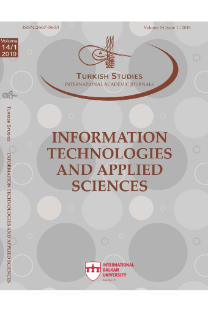Türkiye’de Faaliyet Gösteren Emeklilik Sigorta Şirketlerinde Özsermaye Tahmini: Bulanık Hedef Programlama Örneği
Estimation Equity of Pension Insurance Company Operating in Turkey: Fuzzy Goal Programming Example
___
- Aouni, B., Colapinto, C., & La Torre, D. (2014). A fuzzy goal programming model for venture capital investment decision making. INFOR: Information Systems and Operational Research, 52(3), 138-146. https://doi.org/10.3138/infor.52.3.138
- Bairoliya, N. (2019). Pension plan heterogeneity and retirement behavior. European Economic Review, 116, 28-59. https://doi.org/10.1016/j.euroecorev.2019.03.005
- De, M., Mangaraj, B. K., & Das, K. B. (2018). A fuzzy goal programming model in portfolio selection under competitive-cum-compensatory decision strategies. Applied Soft Computing, 73, 635-646. https://doi.org/10.1016/j.asoc.2018.09.006
- Guo, Y., Tian, M., Han, K., Johnson, K., & Zhao, L. (2016). What determines pension insurance participation in China? Triangulation and the intertwined relationship among employers, employees and the government. The International Journal of Human Resource Management, 27(18), 2142-2160. https://doi.org/10.1080/09585192.2016.1164219
- Iskander, M. G. (2004). A fuzzy weighted additive approach for stochastic fuzzy goal programming. Applied Mathematics and Computation, 154(2), 543-553. https://doi.org/10.1016/S0096- 3003(03)00734-3
- Jana, D. K., Sahoo, P., & Koczy, L. T. (2017). Comparative study on credibility measures of type-2 and type-1 fuzzy variables and their application to a multi-objective profit transportation problem via goal programming. International Journal of Transportation Science and Technology, 6(2), 110-126. https://doi.org/10.1016/j.ijtst.2017.06.002
- Jayaraman, R., Liuzzi, D., Colapinto, C., & Malik, T. (2017). A fuzzy goal programming model to analyze energy, environmental and sustainability goals of the United Arab Emirates. Annals of Operations Research, 251(1-2), 255-270. https://doi.org/10.1007/s10479-015-1825-5
- Jiménez, M., Bilbao‐Terol, A., & Arenas‐Parra, M. (2018). A model for solving incompatible fuzzy goal programming: an application to portfolio selection. International Transactions in Operational Research, 25(3), 887-912. https://doi.org/10.1111/itor.12405
- Kocadağlı, O., & Keskin, R. (2015). A novel portfolio selection model based on fuzzy goal programming with different importance and priorities. Expert Systems with Applications, 42(20), 6898-6912. https://doi.org/10.1016/j.eswa.2015.04.047
- Komsiyah, S., & Centika, H. E. (2018). A Fuzzy Goal Programming Model for Production Planning in Furniture Company. Procedia Computer Science, 135, 544-552. https://doi.org/10.1016/j.procs.2018.08.207
- Lee, A. H., Chen, H. H., & Kang, H. Y. (2017). A conceptual model for prioritizing dam sites for tidal energy sources. Ocean Engineering, 137, 38-47. https://doi.org/10.1016/j.oceaneng.2017.03.039
- Lin, C. C., Liu, Y. T., & Chen, A. P. (2016). Hedging an option portfolio with minimum transaction lots: A fuzzy goal programming problem. Applied Soft Computing, 47, 295-303. https://doi.org/10.1016/j.asoc.2016.06.006
- Nielsen, P. H. (2006). Utility maximization and risk minimization in life and pension insurance. Finance and Stochastics, 10(1), 75-97. https://doi.org/10.1007/s00780-005-0166-7
- Nomani, M. A., Ali, I., Fügenschuh, A., & Ahmed, A. (2017). A fuzzy goal programming approach to analyse sustainable development goals of India. Applied Economics Letters, 24(7), 443- 447. https://doi.org/10.1080/13504851.2016.1200178
- Özkan, M.M. (2003). Bulanık Hedef Programlama. Ekin Yayınevi.
- Saxena, L. K., Jain, P. K., & Sharma, A. K. (2018). A fuzzy goal programme with carbon tax policy for Brownfield Tyre remanufacturing strategic supply chain planning. Journal of Cleaner Production, 198, 737-753. https://doi.org/10.1016/j.jclepro.2018.07.005
- Talonen, A., Holmlund-Rytkönen, M., & Strandvik, T. (2018). Mental models of customer ownership in the executive board: A case study in the pension insurance sector. Journal of Co-operative Organization and Management, 6(1), 1-10. https://doi.org/10.1016/j.jcom.2018.02.001
- Wong, J. T. (2020). Dynamic procurement risk management with supplier portfolio selection and order allocation under green market segmentation. Journal of Cleaner Production, 253, 119835. https://doi.org/10.1016/j.jclepro.2019.119835
- Wu, L. C., & Tsai, I. C. (2014). Three fuzzy goal programming models for index portfolios. Journal of the Operational Research Society, 65(8), 1155-1169. https://doi.org/10.1057/jors.2013.47
- Yang, Y., & Zhou, W. (2017). Regional Disparities in China’s Basic Pension Insurance and Labor Migration. The Chinese Economy, 50(5), 323-338. https://doi.org/10.1080/10971475.2017.1345269
- ISSN: 2667-5633
- Yayın Aralığı: 4
- Başlangıç: 2006
- Yayıncı: ASOS Eğitim Bilişim Danışmanlık Otomasyon Yayıncılık Reklam Sanayi ve Ticaret LTD ŞTİ
Görsel Sanatlar-Yapay Zekâ İş Birliğine Yönelik İşlevsel Sınıflandırma Derlemesi
Hasan Ufuk GÖKÇE, Kamil Umut GÖKÇE
MRIKardiyak MR Görüntülerinde Sol Kulakçık Bölütlenmesi İçin Derin Öğrenme Tabanlı Hibrit Model
Öğrencilerin 21. Yüzyıl Öğrenme Becerileri İçin Veri Toplama Aracı: Geçerlik ve Güvenirlik Çalışması
Lemmatizer: Akıllı Türkçe Kök Bulma Yöntemi
Özge DOĞUÇ, Ömer Berkay AYTAÇ, Gökhan SİLAHTAROĞLU
Kamil Umut GÖKÇE, Hasan Ufuk GÖKÇE
Müzik Eğitiminin Yeni Yüzü: Dijital Teknopedagojik Müzik (DiTeM) Eğitimi
